By Kelly Billing and Larry Carnes
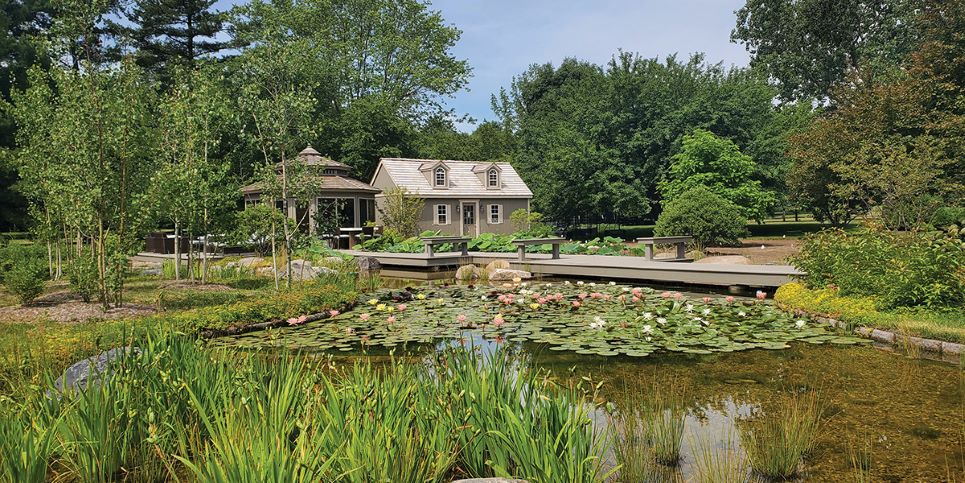
Use Nature as Inspiration When Choosing Aquatic Plants
Nature has long served as inspiration to the pond builder. Wind and rain-weathered rock formations, jutted outcroppings and eroded stone from centuries of varying seasonal water flows are all naturally occurring structures that are often studied and near replicated to bring water to life in the landscape. Moving water creates a space that soothes the stress of the day and contributes to a greater sense of wellbeing.
A long walk along the edge of a body of water reveals broad swaths of fern, moss, golden club, swamp hibiscus, cattail, arrowhead, arrow arum, pickerel rush, sedges, grasses and even lotus, to name a few. The foliage softens the harsh lines of boulders and seamlessly blends water with landscape. Aquatic vegetation has a proclivity for finding itself tucked between cracks and crevices or establishing itself in massive stands along the banks and in the water.
Bring a Garden to Life

Nothing enhances this saying like the successful addition of plants. Even the smallest containers that hold water will invite insects, amphibians and microbial guests to bathe, breed, gather pollen and take up residence. This continuance of aquatic life is reliant on places that foster survival and mimic natural, biologically diverse ecosystems. For instance, the simplicity of burying a large container (36-60 inches in diameter and 12-15 inches deep) and naturalizing lotus or waterlilies will draw abundant wildlife. Bees, butterflies, beetles, water skates, tadpoles, frogs and birds are all reliant on water for survival. Even a single plant will provide shade, cover, oxygen and nutrient management, creating an inviting habitat that will advance a simple ecosystem.
Replicating nature is as important with plants as it is with stone. The friendship between Larry Carnes of Reflections Water Gardens and Kelly Billing of Water Becomes a Garden was kindled by a mutual admiration of water feature artisans. Just like Anthony Archer-Wills and David Duensing, who did exactly that — they dreamed big and executed beautiful replicas of natural aquatic environments and took great care to consider the interaction between plants and stone while planning.
Conceptually, not all pond builders have the vision to include plants as part of the big picture. However, these masters always went the extra mile to plan (and plant) for the greater good of the ecosystem and the long-term enjoyment of their clients.
Aquatic Plants Cleanse Water Bodies
Aquatic plants have been cleansing water bodies for millions of years. Undisturbed wetlands are capable of filtering water on its way to massive water bodies. Bays, lakes and rivers would quickly degrade without them. Their ability to detoxify, filter and manage nutrients is well documented. Ornamental plants may have less nutrient uptake than their aggressive counterparts like cattail and phragmites, but they should not be dismissed for their ability to filter water. By harnessing and enhancing that qualification, plants can be competent for the remediation of industrial runoff from airports, mining and petroleum operations. Even in individual residences in remote locations where access to infrastructure like stormwater management and water-treatment facilities is absent. In a simplified purification system, lotus and waterlilies grown in containers capture roof runoff to for cooking and drinking water.
Build Ponds to Suit
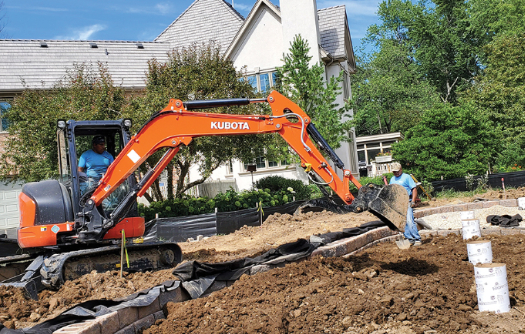
Balance, scaling and planning are essential to replicating the benefits of what occurs naturally for the benefits of improved water quality and ecosystem development. Plants in small pots don’t create a web of growth that provides safe harbor for all the living things that are drawn to water, nor do they have the ability to support the smallest life forms.
“Chronically, I see plants in undersized containers or being forced into habitats that aren’t conducive to survival or adequate for plants to naturalize,” says Kelly Billing. “This cannot be easily corrected without major interventions. Simply put, planning is important.”
The networks that are the most effective rely on a bottom-up approach for sustenance to be able to fully thrive. That means providing plenty of area for even the smallest of inhabitants to prosper. Building a healthy environment will reduce or eliminate the need for remediation.
Choosing Aquatic Plants for a Water Garden
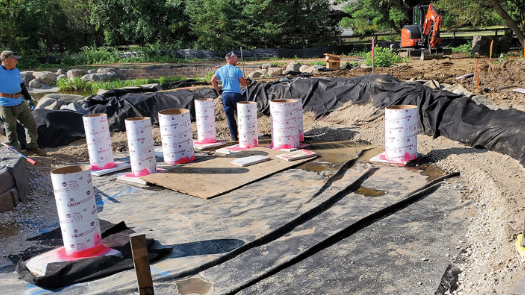
Like a commercial office space, ponds should be built to suit. Planning is everything. Plants have personalities, strengths and weaknesses. Much like allocating space in an office building, a good understanding of the proper cultivar selection and the most accommodating parameters will ensure success and impact. The payoff will be worth the extra effort.
“The edge of a pond should not be defined as a ring of rocks with water in the center,” says Larry Carnes. “Large features with masses of plants should be carefully planned to coordinate plantings for time of day, season, color, shape and movement.”
The edge of the water feature is softened by a combination of carefully selected and placed aquatic plantings, natural stone and terrestrial landscape beds.
Loads of Lotus
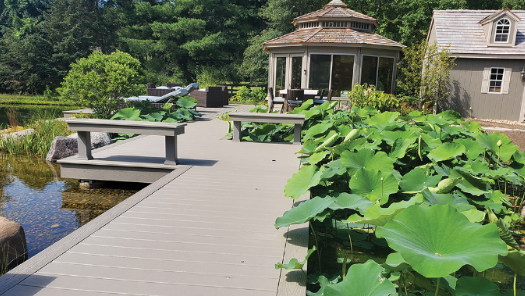
the lotus bed erupts in a sea of color.
While the project featured does not contain a stream in the traditional sense, it functions more like the Florida Everglades. Half of the 1,500-square-foot plant filter is dedicated to lotus.
“The concept behind the lotus bed was to recreate the growing conditions that the lotus plants would find in a natural environment,” Carnes says. “Essentially, the lily and lotus beds are completely contained; they are like one big planting pot that allows the plants’ rhizomes to spread as they would in nature. The water skims slowly over the top of the planting beds, which is what lilies and lotus typically prefer.”
The slow flow across the entire area enhances nutrient uptake. It continually brings a fresh supply of fertilizer generated by pollen, leaves and other decaying matter.
Creating Boundaries
Separation walls were created underwater to contain the otherwise rambling plants. The individual sections of the wetland filter are partitioned by boulders and liner. This creates four physically distinct aquatic planting zones, each with its own unique physical characteristics, flow methodologies and aquatic plant selections.
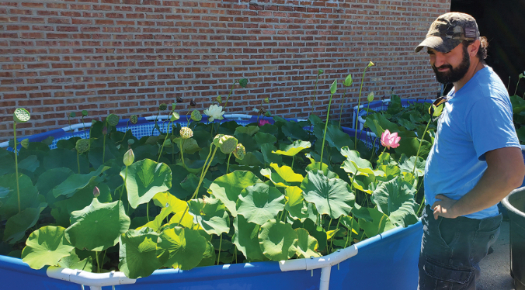
Setting these physical planting boundaries keeps the ecosystem in check while still allowing substantial growth for dramatic effect. The area was excavated to 2 feet below water level. Underlayment was placed in the lotus planting zone and covered by EPDM liner. A second layer of geotextile was added to protect the base layer of the wetland filter. Spoils from the excavation were placed in the lotus bed to fill 12 of the 24 inches. The soil stays in place, much like in a natural stream, once everything has settled in.
The boardwalk was added as a way of providing spontaneous interaction with the wetland environment. Carnes dotes on this element of the project.
“You can lean over a lotus flower and admire its smell and the intricacy of its petals,” he says. “You can watch the insects buzz across the surface of the water while bees harvest pollen and observe frogs and tadpoles that have made their homes among the rocks. You can experience nature in your own backyard.”
Right Plant, Right Place

The other half of the wetland filter’s real estate is dedicated to abundant waterlilies and various shallow-water plants, collectively keeping the shallow-water areas shaded and filtered. No single plant is usually capable of providing long-term water quality benefits, because each has specific and sometimes changing nutrient needs. It is also important to incorporate plants whose peak growing varies throughout the year. Cool-season plants have nutrient demands early in the growing season, and warm-season plants make the best use of excess nutrients during the heat of summer.
It is meaningful to get to know plants. Grow them and experiment with how they respond in contrasting environments in your region.
“You can fail a client by choosing the wrong plants or the wrong quantities,” Billing advises. “Choose a handful of plants and learn them well. Right plant, right place.”
What works in one area of the country may not work in another. For example, lotus is a sun worshipper in most places. But in dry, windy climates, they are best protected on the east side of a building to reduce evaporative moisture due to wind and extreme afternoon temperatures that could damage the leaves.
Be certain to use plants in the best situation for success. Just as selecting and placing rocks gets easier over time as you get to know them, the same applies to planting and growing. The more experience you have, the more confidently you’ll proceed! This project is a visually stunning masterpiece founded on all the elements and principles that capitalize on natural processes to ensure success.


